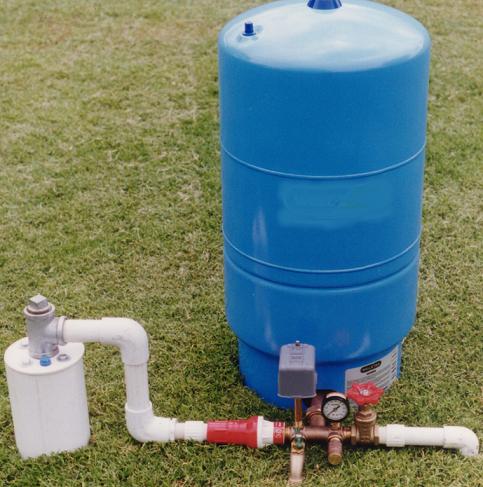A Cycle Stop Valve or CSV makes the amount of flow coming from your pump exactly match the amount of flow you are using. The CSV1 has a minimum flow of 1 GPM. So as long as your shower or sprinklers are using at least 1 GPM, The water comes directly from the pump, goes through the CSV at 50 PSI, and then right past the pressure tank to the sprinklers, shower, or where ever you are using water. In other words, as long as you are using more than 1 GPM, water does not go into the tank so, the size of the tank is unimportant. However, when you are not using any water, the 1 GPM that is still going through the CSV has no place left to go except the pressure tank. The pressure tank is then slowly filled from 50 PSI to 60 PSI and the pressure switch shuts off the pump. When the pump is off, you are able to use the water stored in the tank for ice makers, toilets, hand washing, and leaks before the pump will have to start up again. This is when the size of the tank becomes important. You do not want the pump to start up every time you flush a toilet or the ice maker fills. So a tank that holds 5 gallons of water, which is about a 20 gallon actual size tank, will allow you to flush a 1.6 gallon toilet three times before the pump must restart. Tanks smaller than 20 gallon size can be used but, you must make sure that even at the worst case scenario, the pump does not cycle on and off more times than the pump/motor manufacturer suggest. With your size pump the manufacturer recommends no more than 100 starts per day. We know the CSV will not allow the pump to cycle on and off at all as long as more than 1 GPM is being used so, the worst case would be a leaking faucet or running toilet that is using about ½ of a gallon per minute. In this case when the pump starts at 40 PSI, the CSV150 will let the tank fill at full flow from the pump until pressure reaches 50 PSI. Then the CSV closes down to 1 GPM. ½ of this GPM is going to the leaking faucet and the other ½ of a GPM is filling the tank from 50 to 60 PSI. The tank holds 5 gallons between 40 and 60 PSI so, it is half full at 50 PSI. Filling the last half of the tank, which is 2.5 gallons, at ½ of a GPM will cause the pump to run for 5 minutes. When the tank is filled to 60 PSI the pressure switch shuts off the pump. Now there is still have ½ of a GPM leaking at the faucet so the 5 gallons in the tank will be drained in 10 minutes as the pressure drops from 60 to 40 PSI. At 40 PSI the pressure switch starts the pump and the process is repeated as long as the faucet continues to leak. 5 minutes to fill the tank and 10 minutes to drain it is a cycle time of 15 minutes. Doing the math you will see that there are 1440 minutes in a day. 1440 minutes divided by 15 minutes of cycle time leaves 96 cycles per day. This is just under the 100 maximum starts per day recommended by the pump/motor manufacturer so 20 the gallon size tank is the smallest that should be used. The less number of cycles on your pump, the longer your pump system will last. Doubling the size of tank to 40 gallon size will cut the number of cycles in half from 96 to 48 per day. Of course if you do not have any leaks in the system or do not have any water uses that are less than 1 GPM, a smaller tank will work fine. Pump systems for irrigation only that are not attached to a house have much less chances for leaks and can use smaller tanks. Smaller than 20 gallon size tanks can also be used for house systems as long as you do not have any leaks. Cycle Stop Valves, Inc. always likes to assume worst case scenarios and therefore does not recommend smaller than a 20 gallon size tank with this valve. Use the above information to decide what size tank you would like to use. Also our tank size calculator makes it easy to figure your particular worst case scenario. See these Links;
http://cyclestopvalves.com/runtime_app.phphttp://cyclestopvalves.com/tanksizing_12.html
